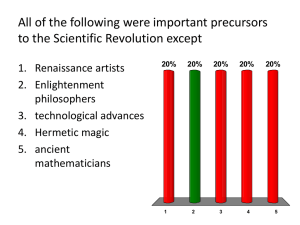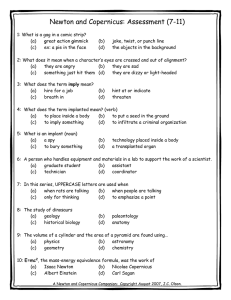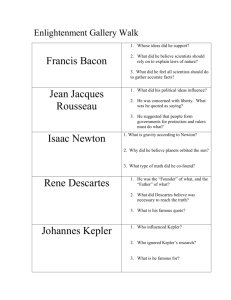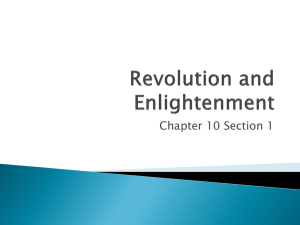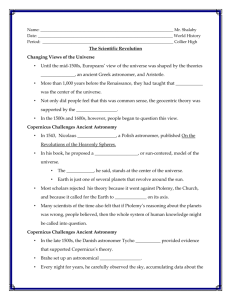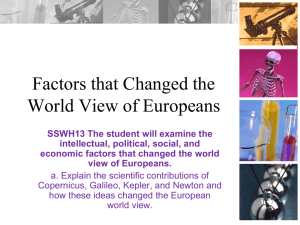t11e
advertisement
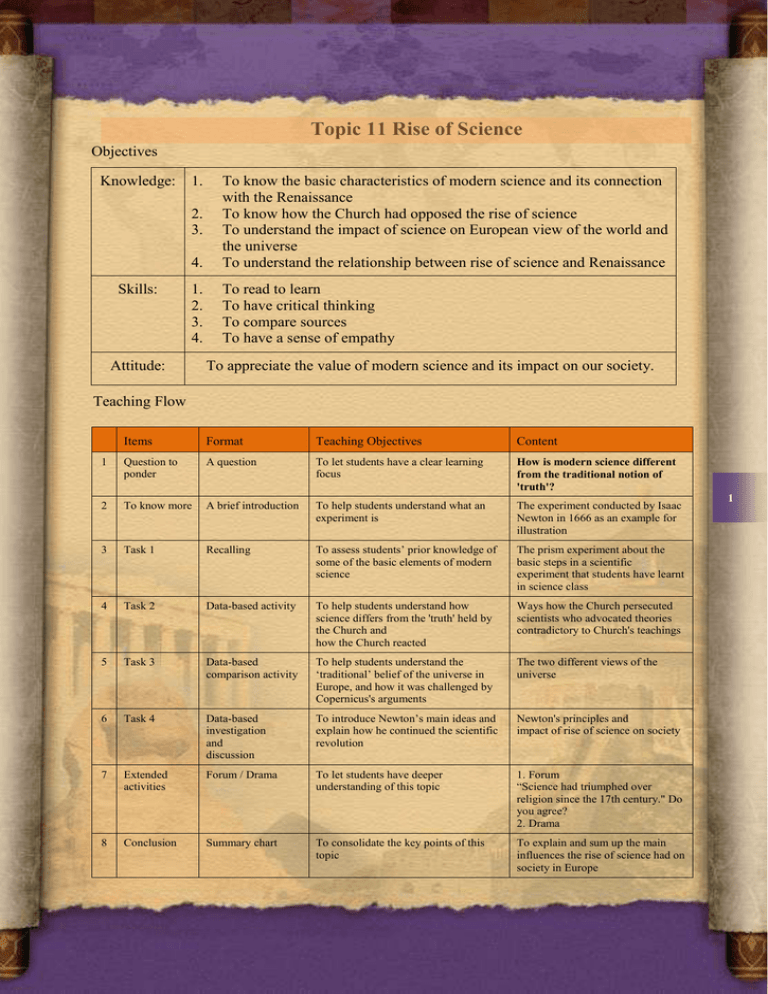
Topic 11 Rise of Science Objectives Knowledge: 1. 4. To know the basic characteristics of modern science and its connection with the Renaissance To know how the Church had opposed the rise of science To understand the impact of science on European view of the world and the universe To understand the relationship between rise of science and Renaissance 1. 2. 3. 4. To read to learn To have critical thinking To compare sources To have a sense of empathy 2. 3. Skills: Attitude: To appreciate the value of modern science and its impact on our society. Teaching Flow Items Format Teaching Objectives Content 1 Question to ponder A question To let students have a clear learning focus How is modern science different from the traditional notion of 'truth'? 2 To know more A brief introduction To help students understand what an experiment is The experiment conducted by Isaac Newton in 1666 as an example for illustration 3 Task 1 Recalling To assess students’ prior knowledge of some of the basic elements of modern science The prism experiment about the basic steps in a scientific experiment that students have learnt in science class 4 Task 2 Data-based activity To help students understand how science differs from the 'truth' held by the Church and how the Church reacted Ways how the Church persecuted scientists who advocated theories contradictory to Church's teachings 5 Task 3 Data-based comparison activity To help students understand the ‘traditional’ belief of the universe in Europe, and how it was challenged by Copernicus's arguments The two different views of the universe 6 Task 4 Data-based investigation and discussion To introduce Newton’s main ideas and explain how he continued the scientific revolution Newton's principles and impact of rise of science on society 7 Extended activities Forum / Drama To let students have deeper understanding of this topic 1. Forum “Science had triumphed over religion since the 17th century." Do you agree? 2. Drama 8 Conclusion Summary chart To consolidate the key points of this topic To explain and sum up the main influences the rise of science had on society in Europe 1 To know more In science lessons, you had conducted this experiment. You passed a beam of white light into a prism, and observed that it divided into seven colours. Did you know that this was an experiment conducted by Isaac Newton in 1666? He discovered this while making a telescope with different lenses, and he found that that it was refraction which separated the colours. Newton proved himself right with an experiment. We also know he was right because we can conduct the same experiment, because an experiment is a repeatable event in which we can observe the same action. Its key is reason and observation. prism white light 2 Source:http://upload.wikimedia.org/wikipedia/commons/0/06/Prism_rainbow_schema.png Task 1: What is Science? When you and Newton reach this scientific conclusion, certain steps have already taken place! These steps formulate the essence of modern scientific method. Can you arrange the following steps in order? Experiment Conclusion Observation Suggested answer: Hypothesis - Experiment Hypothesis (assumption) - Observation - Conclusion Topic 11 Rise of Science Task 2: Religious persecutions Modern science began to emerge in the 15th to the 16th centuries. It emphasized the use of observation and experiment, all constituted a sharp contrast to the Church's uncompromising insistence upon their own teaching. Some new scientific theories have been considered as heresies by the Church. Study Sources A and B carefully and then answer the following questions. Source A is about religious persecutions Religious persecutions In the 15th and 16th centuries, the Church was very concerned about heresies and witchcraft (theories that did not seem to agree with to the Bible). Heretics and witches were arrested and put on trials. Although people began to put their faith in science, magic and witches were still very common. During this time, witches were hunted down or burnt to death, sometimes with very little evidence. Apart from persecuting witches, the Church also held trials on scientists. One famous example was Giordano Bruno's case. Bruno was a supporter of Copernicus’ theory and was burnt at the stake in 1600. Source B shows one of the ways of religious persecution. 2 Source: http://commons.wikimedia.org/wiki/Image:Willisau_1447.JPG 1. According to Source A, what was considered as the standard of ‘truth’ in the 15th and the 16th century? Explain your answer. Suggested answer: According to Source A, the Bible or the teaching of the Church was considered as the standard of ‘truth’ in the 15th and the 16th century. Those who had ideas against the Church were punished or even put to death. 2. With reference to Sources A and B, which adjective below best describes the Church's attitude towards beliefs that were different from its own? Choose the right answer from the following list of words. Identify the words from Source A which show this attitude. Welcoming Hostile Ignore Open Curious Neutral Suggested answer: The Church’s attitude was hostile. The following words from Source A can show this attitude: arrest, burnt to death 3. Which form of punishment is shown in Source B? Suggest answer: Burnt to death 4. Do you think the punishment in Source B would enable the Church to consolidate its power? Why? Suggested answers: The punishment could help the Church secure its position in Europe by creating more fear of the Church among people, but it could not convince the people to put their faith in the Church. The Church might lose its popularity even more. 4 Task 3: Did the sun go round the Earth? Modern science was a fundamental breakthrough from the 'old' world by introducing not only new perspectives of the universe, but also new scientific methods in the quest for truth. Instead of blindly believed what the Church told them, people increasingly relied on human reason, a belief which set its root in the rise of humanism during the Renaissance. Gradually the people's faith in the Church was replaced by faith in human reason. Source C is about the belief that the earth was the centre of the universe Before the 16th century, people thought that the world was in the centre of the universe and the sun went round the earth. Arab astronomers had studied hard about the movement of the planets. They noticed that Mars did not move in a straight line: it went forward, back and forward again. This was a problem that many astronomers tried to solve, but could not, because they all believed that the sun went round the earth. This was because for centuries, the Church had taught that the truth about the world was revealed in the Bible. And from its interpretation of the Bible, it was the sun that went around the earth. The Church had for its support the Greek theory of the universe as propounded by Aristotle, who believed that the earth was the centre of the universe. Topic 11 Rise of Science Source D is a description of the beliefs and methods of Copernicus and Galileo In 1539, Nicolaus Copernicus (1473-1543) came up with his theory that the Earth went round the sun. Observation of the planets was there for all to see. His theory explained the movements of the planets which people observed. However, this theory took a strange and political turn as it went against the teaching of the Church. The Church tried to stop the publication of Copernicus’ ideas. Copernicus died in 1543 at about the time his book was published. It was widely read by scholars, but it was only a hypothesis. However, Galileo (1564-1642) took it a step further when he published a book in 1632 in which he proved that Copernicus’ theory was not only a guess, but can be proved. He was required by the Church to take back his argument and was put under house arrest. 1. Based on Sources C and D, fill in the blanks in the table below: Suggested answer: People before the 16th century Copernicus and Galileo Which is in centre of the universe (Earth/Sun)? the Earth the Sun How did they reach their answer to this question? based on their interpretation of the __Bible_____ and the theory by ___Aristotle _____. formulated a __hypothesis____, based on __observation____ of the planets, and proved it. 2. Who followed the principles of modern science? Suggested answer: Copernicus and Galileo Task 4: Did science win over religion? Source E is about Isaac Newton’s law of gravity. Isaac Newton discovered the law of gravity, and used that to explain the movement of the planets. He published his famous book, Principia Mathematica, in 1687. In it, Newton put forward the general principles of science: 1. Science only accepts theories that can explain what we observe. 2. Scientists look for causes which are sufficient to give the same effects when being repeated in experiments. 3. Scientists draw conclusions from experiments and assume these conclusions to be true until they are proved, by experiments, to be wrong. 5 1. With reference to Sources D and E, how were Newton's scientific methods similar to those of Copernicus and Galileo? (Hint: what are the keywords that they both emphasize?) Suggested answer: They all emphasized the use of human observation and proving theories with experiments. Their methods corresponded to the basic principles of modern science. 2. Group discussion: Newton's scientific methods soon became the foundation of modern science. How do you think Europe would be transformed by these new developments in science? Try to determine whether the item in each box would increase or decrease. Then write down the reason(s). (See next page.) Suggested answer: Impact of the Rise of Science in the 16th century 2 on the Church on people and science People's faith in the Church at that time would increase/decrease decrease Reason: Newly arising scientific theories had proved that some of the Church's teachings on the universe were wrong. People's faith in human reason would increase/decrease increase Reason: People found out that by using their own observation and reasoning they could find out the truth, without blindly believing in what the Church told them at that time. Scientific discoveries would increase/decrease increase Reason: Scientists now learned to use observation and experiments to find out more about the universe. People's interest in the world and the universe would increase/decrease increase Reason: Scientists and people now had more desire to find out more about the universe after they found out some traditional beliefs were wrong. Topic 11 Rise of Science Extended Activity(1) Forum : “Science had triumphed over religion since the 16th century.” Do you agree? Teaching Tips: Divide the class into two groups, with one side for and one side against the statement. Questions for discussion: 1. Was science successful in challenging the supremacy of the Church? Why? 2. Was the Church successful in controlling the rise of science? Why? 3. Which had more far-reaching impact on European society? The Church or science? Extended Activity(2) 7 Drama: A trial scene in the 17th century: Was the Earth flat? Church) (Scientists vs. the Teaching Tips: Imagine a group of scientists tried to argue that the Earth is a sphere, but the Church was angered by this theory because they believed the Bible says that the Earth has 'four corners' and therefore must be flat. Revelation 7:1 “After these things I saw four angels standing on FOUR CORNERS OF THE EARTH.” Write a script for a trial scene in which the two groups debated about this issue. Your scene should include at least 2 scientists and 2 members from the Church. You should also think of which side would win the debate. Pay attention to the arguments each side would use, their attitudes, methods, and even emotions! Act out your script to your class! Role play cards: The Church Your goal: - to defend the Church's supreme authority - to attack the scientists' new methods of finding the truth The Scientists Your goal: - to defend modern science and its value - to challenge the Church's claim Your belief: Only the Church has the divine authority to interpret the Bible and decide what the truth is. No one could argue for a different understanding of the Bible. Your belief: Only through objective observation and experiments can we find the real truth Your argument: Since the Bible mentions “FOUR CORNERS”, then it should be the words of God. The Church has the divine responsibility to protect it and punish those who are unfaithful. Your argument: - We can see the horizon is slightly curved. - Magellan's ship has already sailed around the world in 1519 Conclusion 8 In this topic, the student has been introduced to the idea that it was from the 16th century that observation and experiment were made the cornerstone of science. This new approach was at one time opposed by the Church, but by the 17th century, it had clearly won. Summary chart
